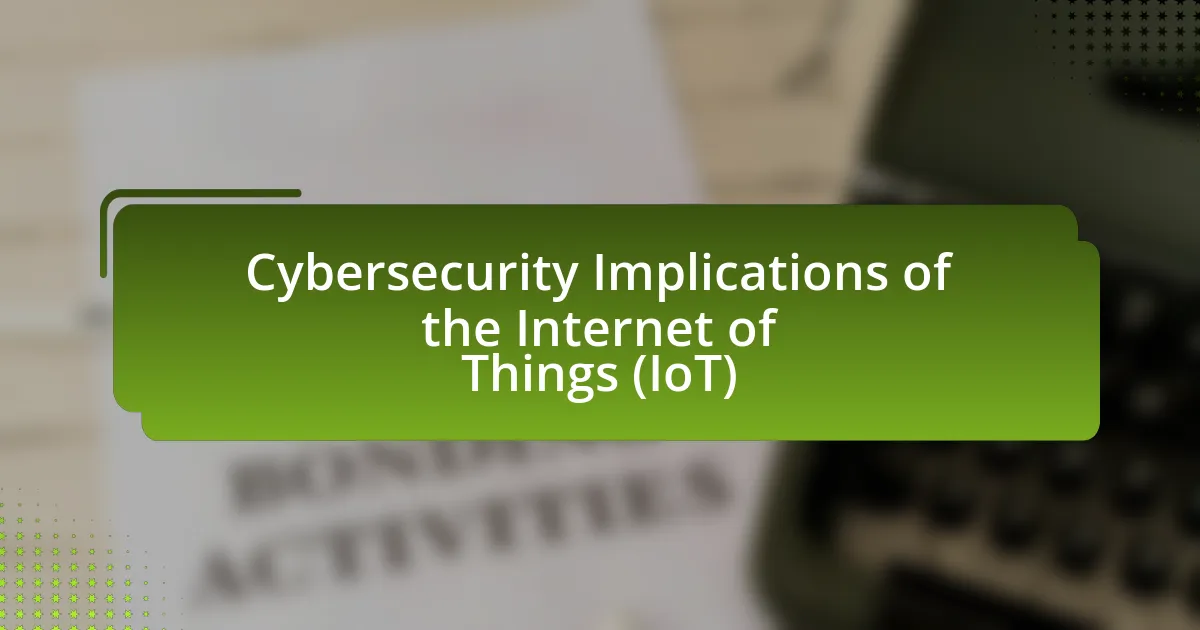The article examines the cybersecurity implications of the Internet of Things (IoT), highlighting the increased vulnerabilities associated with the proliferation of IoT devices. It discusses common security weaknesses such as weak authentication, insecure communication, and inadequate software updates, which can lead to data breaches and unauthorized access to sensitive information. The article emphasizes the critical need for robust cybersecurity measures, including strong authentication protocols, regular firmware updates, and encryption, to protect both user privacy and data security. Additionally, it addresses regulatory challenges and the role of emerging technologies like artificial intelligence in enhancing IoT security.
--The-cybersecurity-implicati-1.webp)
What are the Cybersecurity Implications of the Internet of Things (IoT)?
The cybersecurity implications of the Internet of Things (IoT) include increased vulnerability to cyberattacks, data breaches, and unauthorized access to sensitive information. IoT devices often lack robust security measures, making them attractive targets for hackers. For instance, a report by the Cybersecurity & Infrastructure Security Agency (CISA) highlighted that many IoT devices have weak default passwords and insufficient encryption, which can lead to exploitation. Additionally, the interconnected nature of IoT devices means that a breach in one device can compromise an entire network, amplifying the potential impact of cyber threats.
How does the proliferation of IoT devices impact cybersecurity risks?
The proliferation of IoT devices significantly increases cybersecurity risks due to their inherent vulnerabilities and the sheer volume of devices connected to networks. Each IoT device can serve as a potential entry point for cyberattacks, as many lack robust security measures, making them susceptible to exploitation. For instance, a report by the Cybersecurity & Infrastructure Security Agency (CISA) highlights that over 50% of IoT devices have known vulnerabilities that can be easily exploited by attackers. Additionally, the rapid growth of IoT devices, projected to reach over 75 billion by 2025, exacerbates the challenge of securing networks, as organizations struggle to manage and monitor these devices effectively. This combination of widespread deployment and insufficient security protocols elevates the overall risk landscape in cybersecurity.
What types of vulnerabilities are commonly found in IoT devices?
Common vulnerabilities found in IoT devices include weak authentication, insecure communication, and inadequate software updates. Weak authentication allows unauthorized access due to default or easily guessable passwords, which has been documented in various studies, including a report by the Internet of Things Security Foundation, highlighting that many devices ship with factory-set credentials. Insecure communication occurs when data transmitted between devices is not encrypted, making it susceptible to interception; a notable example is the lack of encryption in many consumer-grade IoT devices. Inadequate software updates leave devices exposed to known vulnerabilities, as many manufacturers do not provide timely patches, which has been evidenced by incidents such as the Mirai botnet attack that exploited outdated firmware in IoT devices.
How do these vulnerabilities affect user privacy and data security?
Vulnerabilities in the Internet of Things (IoT) significantly compromise user privacy and data security by exposing sensitive information to unauthorized access. For instance, insecure devices can be exploited by cybercriminals to intercept personal data, leading to identity theft or unauthorized surveillance. A report by the Ponemon Institute in 2020 indicated that 63% of organizations experienced a data breach due to IoT vulnerabilities, highlighting the direct correlation between these weaknesses and the risk to user data. Furthermore, inadequate encryption and authentication mechanisms in IoT devices can allow attackers to manipulate or control devices, further endangering user privacy and data integrity.
Why is cybersecurity a critical concern for IoT implementations?
Cybersecurity is a critical concern for IoT implementations because the interconnected nature of IoT devices increases vulnerability to cyberattacks. Each device can serve as a potential entry point for malicious actors, leading to data breaches, unauthorized access, and even physical damage. According to a report by Cybersecurity Ventures, cybercrime is projected to cost the world $10.5 trillion annually by 2025, highlighting the financial impact of inadequate security measures in IoT systems. Furthermore, a study by the Ponemon Institute found that 57% of organizations experienced a data breach due to insecure IoT devices, underscoring the urgent need for robust cybersecurity protocols in IoT deployments.
What are the potential consequences of a cybersecurity breach in IoT?
A cybersecurity breach in IoT can lead to significant consequences, including unauthorized access to sensitive data, disruption of services, and potential physical harm. Unauthorized access can result in the theft of personal information, financial data, or proprietary business information, as evidenced by the 2016 Mirai botnet attack, which compromised over 600,000 IoT devices and led to widespread service outages. Disruption of services can affect critical infrastructure, such as healthcare systems or smart grids, potentially endangering lives and public safety. Additionally, compromised IoT devices can be manipulated to cause physical damage, as seen in incidents where hacked smart home devices were used to unlock doors or disable security systems. These consequences highlight the urgent need for robust cybersecurity measures in IoT environments.
How can IoT-related breaches affect businesses and consumers?
IoT-related breaches can significantly impact businesses and consumers by compromising sensitive data and disrupting operations. For businesses, such breaches can lead to financial losses, reputational damage, and legal liabilities, as evidenced by a report from IBM stating that the average cost of a data breach in 2023 was $4.45 million. Consumers face risks such as identity theft and privacy violations, with a study by McKinsey indicating that 60% of consumers are concerned about their personal data security in IoT devices. These breaches can erode trust in IoT technologies, ultimately affecting market growth and consumer adoption.
What strategies can be employed to enhance IoT cybersecurity?
To enhance IoT cybersecurity, implementing strong authentication mechanisms is crucial. This includes using multi-factor authentication (MFA) to ensure that only authorized users can access IoT devices. According to a report by the Cybersecurity & Infrastructure Security Agency (CISA), devices with weak or default passwords are often exploited, highlighting the need for robust password policies and regular updates. Additionally, employing network segmentation can limit the potential impact of a breach by isolating IoT devices from critical systems. Regular software updates and patch management are also essential, as they address vulnerabilities that could be exploited by attackers. The National Institute of Standards and Technology (NIST) emphasizes the importance of continuous monitoring and incident response plans to quickly address any security incidents.
What role does encryption play in securing IoT devices?
Encryption plays a critical role in securing IoT devices by protecting data integrity and confidentiality during transmission. It ensures that sensitive information, such as personal data and device commands, is encoded and can only be accessed by authorized users, thereby preventing unauthorized access and data breaches. For instance, a study by the Internet of Things Security Foundation highlights that encryption can significantly reduce the risk of data interception, which is crucial given that IoT devices often operate in unsecured environments. By implementing strong encryption protocols, IoT devices can safeguard against various cyber threats, ensuring that both the devices and the data they handle remain secure.
How can regular software updates mitigate cybersecurity risks?
Regular software updates mitigate cybersecurity risks by patching vulnerabilities that could be exploited by attackers. These updates often include security enhancements and bug fixes that address known weaknesses in the software. For instance, a report from the Cybersecurity & Infrastructure Security Agency (CISA) indicates that 85% of successful cyberattacks exploit known vulnerabilities for which patches are available. By consistently applying updates, organizations can significantly reduce their attack surface and enhance their overall security posture against evolving threats.

What are the regulatory and compliance challenges in IoT cybersecurity?
Regulatory and compliance challenges in IoT cybersecurity include the lack of standardized regulations, data privacy concerns, and the difficulty in ensuring compliance across diverse devices and platforms. The absence of a unified regulatory framework leads to inconsistencies in security measures, making it challenging for organizations to implement effective cybersecurity protocols. Additionally, varying international laws, such as the General Data Protection Regulation (GDPR) in Europe, complicate compliance for companies operating globally. The rapid evolution of IoT technologies further exacerbates these challenges, as regulations often lag behind technological advancements, leaving gaps in security and compliance.
How do regulations impact the development of IoT security standards?
Regulations significantly influence the development of IoT security standards by establishing mandatory compliance requirements that manufacturers and service providers must follow. These regulations, such as the General Data Protection Regulation (GDPR) in Europe and the California Consumer Privacy Act (CCPA), create a legal framework that compels organizations to implement robust security measures to protect user data and privacy. For instance, GDPR mandates that companies demonstrate accountability and transparency in data handling, which directly impacts how IoT devices are designed and secured. Consequently, adherence to these regulations drives the creation of standardized security protocols, ensuring that IoT devices meet specific security benchmarks to mitigate risks associated with data breaches and cyberattacks.
What are the key regulations governing IoT cybersecurity?
The key regulations governing IoT cybersecurity include the General Data Protection Regulation (GDPR) in the European Union, the California Consumer Privacy Act (CCPA) in the United States, and the National Institute of Standards and Technology (NIST) Cybersecurity Framework. GDPR mandates strict data protection and privacy measures for personal data, impacting IoT devices that collect user information. CCPA enhances privacy rights and consumer protection for residents of California, influencing how IoT companies handle personal data. NIST provides a voluntary framework that offers guidelines for improving cybersecurity practices, applicable to IoT systems. These regulations collectively establish standards for data protection, privacy, and cybersecurity practices in the IoT landscape.
How can organizations ensure compliance with these regulations?
Organizations can ensure compliance with cybersecurity regulations related to the Internet of Things (IoT) by implementing robust security frameworks and conducting regular audits. Establishing a comprehensive security policy that includes risk assessments, data encryption, and access controls is essential. For instance, the National Institute of Standards and Technology (NIST) provides guidelines that organizations can follow to align their practices with regulatory requirements. Additionally, training employees on security best practices and maintaining up-to-date software can further enhance compliance efforts. Regularly reviewing and updating security measures in response to evolving threats is also critical for maintaining compliance.
What are the best practices for securing IoT devices?
The best practices for securing IoT devices include changing default passwords, regularly updating firmware, using strong encryption, implementing network segmentation, and monitoring device activity. Changing default passwords is crucial as many IoT devices come with easily guessable credentials, making them vulnerable to unauthorized access. Regular firmware updates are essential to patch security vulnerabilities; for instance, a study by the Ponemon Institute found that 60% of IoT devices have known vulnerabilities that could be mitigated through updates. Strong encryption protects data in transit and at rest, while network segmentation limits the exposure of IoT devices to potential threats. Finally, continuous monitoring of device activity helps in identifying unusual behavior that may indicate a security breach.
How can users implement strong authentication methods for IoT devices?
Users can implement strong authentication methods for IoT devices by utilizing multi-factor authentication (MFA), which combines something the user knows (like a password), something the user has (like a smartphone), and something the user is (like biometric data). This approach significantly enhances security by requiring multiple forms of verification before granting access. According to a report by the Cybersecurity & Infrastructure Security Agency (CISA), MFA can reduce the risk of unauthorized access by up to 99.9%. Additionally, users should ensure that default passwords are changed, use unique passwords for each device, and regularly update firmware to protect against vulnerabilities.
What measures can organizations take to secure their IoT networks?
Organizations can secure their IoT networks by implementing strong authentication protocols, regularly updating firmware, and segmenting networks. Strong authentication protocols, such as multi-factor authentication, ensure that only authorized users can access IoT devices, reducing the risk of unauthorized access. Regular firmware updates address vulnerabilities and enhance security features, as evidenced by a report from the Cybersecurity & Infrastructure Security Agency, which states that outdated firmware is a common entry point for cyberattacks. Network segmentation limits the potential impact of a breach by isolating IoT devices from critical systems, thereby containing threats and minimizing damage.

What future trends should we expect in IoT cybersecurity?
Future trends in IoT cybersecurity will increasingly focus on enhanced security protocols, AI-driven threat detection, and regulatory compliance. As the number of connected devices grows, the need for robust security measures becomes critical; for instance, the global IoT security market is projected to reach $73.3 billion by 2025, indicating a significant investment in protective technologies. Additionally, the integration of artificial intelligence in cybersecurity will enable real-time monitoring and response to threats, improving the overall security posture of IoT systems. Furthermore, as governments and organizations implement stricter regulations, compliance will drive the adoption of standardized security frameworks, ensuring that IoT devices meet minimum security requirements.
How is artificial intelligence shaping IoT cybersecurity measures?
Artificial intelligence is significantly enhancing IoT cybersecurity measures by enabling real-time threat detection and response. AI algorithms analyze vast amounts of data generated by IoT devices to identify patterns and anomalies indicative of potential security breaches. For instance, a study by IBM found that AI-driven security systems can reduce the time to detect a breach from months to minutes, showcasing the efficiency of AI in mitigating risks. Additionally, AI can automate responses to threats, allowing for immediate action against detected vulnerabilities, which is crucial given the increasing number of connected devices. This integration of AI into IoT cybersecurity not only improves the overall security posture but also adapts to evolving threats, making it a vital component in safeguarding IoT ecosystems.
What advancements in technology are expected to improve IoT security?
Advancements in technology expected to improve IoT security include the implementation of artificial intelligence (AI) for threat detection, enhanced encryption methods, and the adoption of blockchain technology. AI can analyze vast amounts of data in real-time to identify anomalies and potential threats, significantly reducing response times to security breaches. Enhanced encryption methods, such as quantum encryption, provide stronger protection for data transmitted between IoT devices, making it more difficult for unauthorized users to access sensitive information. Blockchain technology offers a decentralized approach to securing IoT networks, ensuring data integrity and authenticity by creating immutable records of transactions. These advancements collectively address vulnerabilities in IoT systems, thereby strengthening overall security.
How can machine learning help in identifying IoT security threats?
Machine learning can significantly enhance the identification of IoT security threats by analyzing vast amounts of data to detect anomalies and patterns indicative of potential attacks. By employing algorithms that learn from historical data, machine learning models can identify unusual behavior in IoT devices, such as unexpected data transmissions or access attempts, which may signal a security breach. For instance, a study by Ahmed et al. (2020) demonstrated that machine learning techniques could achieve over 95% accuracy in detecting IoT intrusions by leveraging features extracted from network traffic. This capability allows for real-time threat detection and response, improving the overall security posture of IoT ecosystems.
What practical steps can individuals take to protect their IoT devices?
Individuals can protect their IoT devices by implementing strong, unique passwords for each device. This step is crucial because weak or default passwords are a common vulnerability; according to a 2021 report by the Cybersecurity & Infrastructure Security Agency, 80% of data breaches involve weak passwords. Additionally, individuals should regularly update their devices’ firmware to patch security vulnerabilities, as manufacturers often release updates to address newly discovered threats. Enabling network encryption, such as WPA3 for Wi-Fi, further secures data transmission. Lastly, utilizing a separate network for IoT devices can limit exposure to potential attacks, as highlighted by the National Institute of Standards and Technology, which recommends segmenting networks to enhance security.
How can users create a secure home network for IoT devices?
Users can create a secure home network for IoT devices by implementing strong passwords, enabling network encryption, and regularly updating device firmware. Strong passwords prevent unauthorized access, while encryption protects data transmitted over the network. Regular firmware updates address vulnerabilities, as evidenced by a report from the Cybersecurity & Infrastructure Security Agency (CISA) which states that 85% of successful cyberattacks exploit known vulnerabilities that could be mitigated through updates. Additionally, segmenting the network can isolate IoT devices from critical systems, further enhancing security.
What are the common troubleshooting tips for IoT security issues?
Common troubleshooting tips for IoT security issues include regularly updating device firmware, changing default passwords, and implementing network segmentation. Regular firmware updates address vulnerabilities by patching security flaws, as evidenced by the fact that 60% of IoT breaches occur due to outdated software. Changing default passwords enhances security, as many devices come with easily guessable credentials. Network segmentation limits the exposure of IoT devices to potential attacks, reducing the risk of a compromised device affecting the entire network.
It is not possible to provide an answer to the question “
” as it lacks context and clarity regarding what specific information is being requested.



